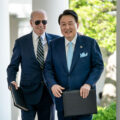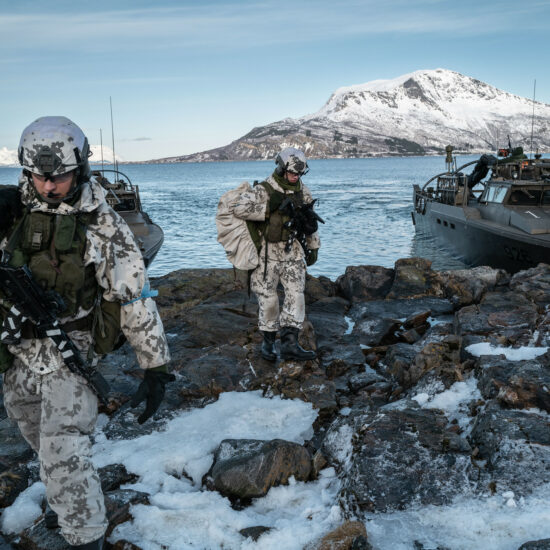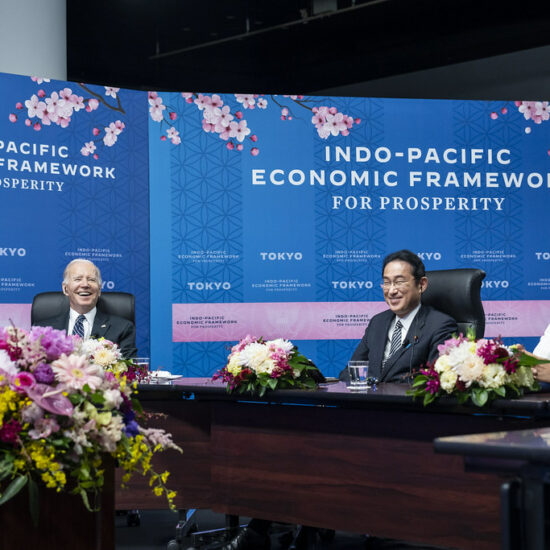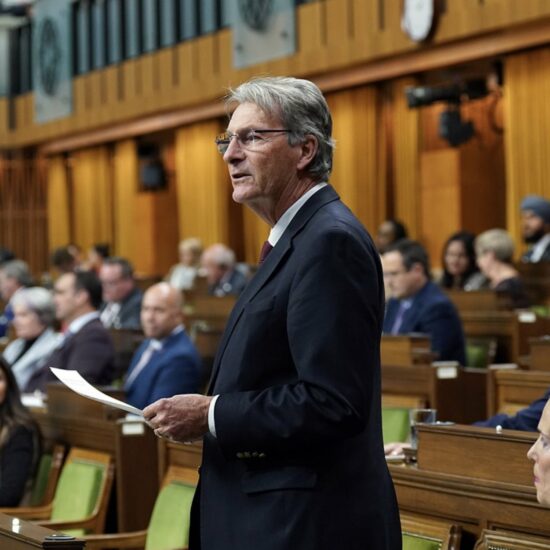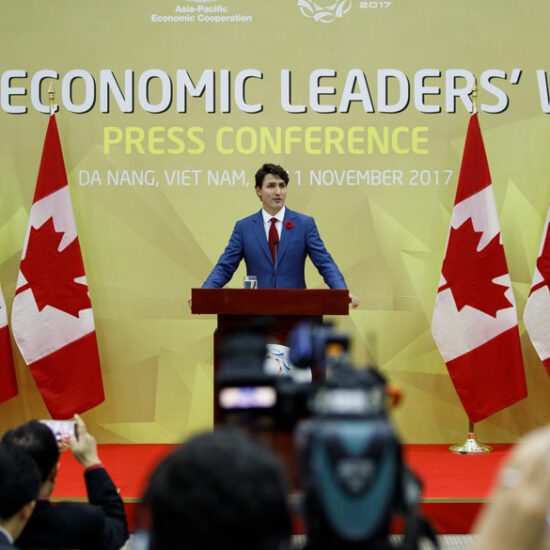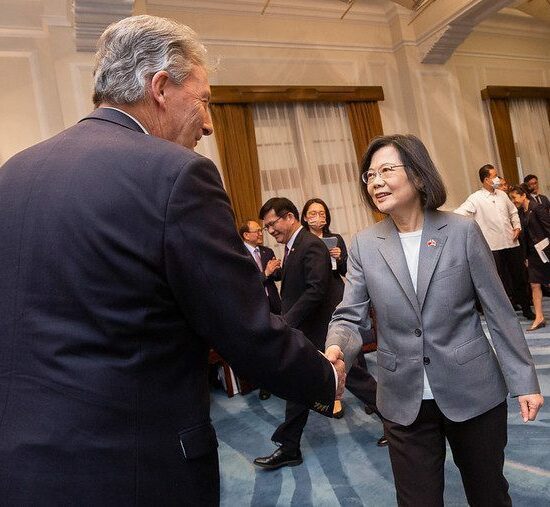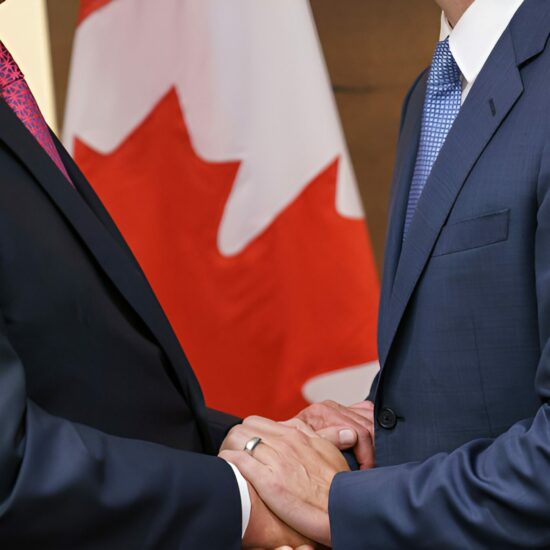
Image credit: Adam Scotti
By Yanling Wang
This paper is published as part of IPD’s China Strategy Project.
China has transformed from a poor planned economy to a gigantic market-oriented economy in a matter of a few decades with its continuous fast economic growth, resulting from a combination of domestic economic reforms and open trade policies. China’s GDP per capita passed the US$10,000 benchmark in 2019; and at US$12,551 in 2021, it surpassed the world’s average (estimated at $12,100) for the first time. As the world’s second largest economy, China’s gross GDP is on path to overtake the US by 2030 at the latest, according to the IMF. China’s economic development has produced several hundred million middle class consumers, an important driving force in consumption of quality goods and services. China’s economic rise has offered enormous opportunities for the world through trade and foreign direct investment (FDI): China has become the world’s largest trading nation, the largest goods trade partner for over 130 countries and economic entities and one of the largest investors. In 2020, China became the largest global investor for the first time—accounting for 20.2% of global FDI flows (the data source for trade and FDI in this paper is China’s Ministry of Commerce except where explicitly noted otherwise).
China is now Canada’s second largest goods trading partner, with recent annual trade (imports plus exports) value of around CAD$75 billion. However, that economic relationship has been under much pressure recently with some in Canada even calling for a “decoupling” with China since Canada-China diplomatic relations went into a downward spiral after December 2018. With a lot at stake, few people may disagree with the assessment of the Canadian foreign minister Melanie Joly in her January 2022 interview on The West Block when she said “There’s a growing influence of China in the world and every single country needs to take a decision as to what their relationship will be with China.” She concluded that was why she “was given the mandate to develop a strategy, which is called an Indo-Pacific strategy, because we need to see, yes, China, but also the region as a whole.” Minister Joly suggests developing a China strategy and an Indo-Pacific strategy.
Despite the increasingly securitized nature of international relations in a multipolar world, evidenced most recently by the Trudeau government’s decision to ban Huawei from its 5G network, China remains an important economic partner for Canada. Developing an effective Canadian strategy for future engagement with China will be constructive for Canadian businesses to make long-term decisions regarding not only the soon-to-be-largest world market, but also the region which is fast becoming the global geo-economic centre of gravity. To achieve this, one must have an informed picture of China’s global economic outreach and the current state of Canada-China economic linkages. Upon closer examination, pursuing a strategy centred on decoupling appears fanciful at best and counterproductive at worst.
China: The World’s Largest Goods Trading Nation
Having transformed itself from a small producer to the world’s largest trading nation, China has taken decisive measures to liberate its economy and to deepen its trade linkages through negotiating and implementing multilateral, regional or bilateral trade agreements over the last few decades. Accession to the World Trade Organization (WTO) in 2001 was one of China’s biggest milestones in its opening-up economic policies, with its average tariff reduced to 7.4% on its 20th anniversary of WTO entry in 2021. The Regional Comprehensive Economic Partnership (RCEP) came into effect on January 1st, 2022, the world’s largest regional trading bloc with China at its core, accounting for about 30% of the world’s population and 30% of global GDP. Although often framed as shallow on labour and environmental standards, RCEP nonetheless lowers trade barriers among its 15 members to promote further trade flows. In fact, RCEP is the first free trade agreement (FTA) including China, Japan and the Republic of Korea, three of the four largest economies in Asia, with Japan and Korea already being, respectively, China’s 4th and 6th largest goods trading partners for 2020. Currently, China maintains 17 FTAs, while implementing or negotiating an additional 8. In its latest move to signal its intention to deepen its economic reforms and to strengthen trade linkages with the world, China applied to join the CPTPP (Comprehensive and Progressive Agreement for Trans-Pacific Partnership).
These efforts have paid off: China’s goods trade valued at US$4.65 trillion in 2020, reinforcing China’s nickname of the “world’s factory”. China’s top 10 goods trading partners in 2020 are indicative of its massive trading power with the big economies and its global outreach with a collective share of 75%. The four high-income developed economies in Asia (Japan, Hong Kong Special Administrative Region—SAR, Korea and Taiwan) plus ASEAN accounted for 40%, a clear sign of their enormous trading network with China. Another collective 35% were shared by large economies consisting of the European Union (14%; Europe), the United States (13%; North America), Australia (4%; Oceania), Brazil (2%; South America) and the Russian Federation (2%; Europe).
China: From FDI Recipient to Two-Way FDI
With its abundance of relatively skilled but cheap labour force and large domestic market, attracting FDI has been one of the major objectives in China’s opening-up policy. To date, China has negotiated and signed bilateral investment treaties with over 100 countries and economic entities (including Canada), which include clauses on expropriation, arbitration, most-favoured-nation treatment, and repatriation of investment proceeds. While global investors responded, accession to the WTO was the turning point in FDI flows both into and out of China.
For the massive FDI inflows, unlike China’s relatively even global trade outreach, Asian firms have always been the largest investors in China, particularly those from Hong Kong SAR. For FDI stock in 2020, Hong Kong investors’ cumulative investment was at US$1.30 trillion, accounting for 53.3% in China’s total inward FDI stock; and FDI stocks from Japan, Korea, Singapore and Taiwan registered a combined value of US$386.17 billion, with a share of 15.8%. On the other hand, FDI from Western firms has been relatively small: as of 2020, firms from major European countries had a cumulative stock of US$116 billion (a share of 4.75%); and from the United States US$90.19 billion (a share of 3.69%).
Foreign-invested enterprises (FIEs) have been a big driving force in China’s trade growth and expansion. Surely, with the presence of FIEs, doing business with China could be doing business with many FIEs investing in China. FIEs’ trade values increased fast: from US$236.7 billion in 2000 (with a trade surplus of US$.21 billion; and a trade share of 49.9% in China’s US$474.3 billion total) to US$1,797.6 billion in 2020 (with a trade surplus of $67 billion; and a trade share of 39.7% in China’s US$4,646.3 billion total), indicating an annualized growth rate of 10.67%. A unique feature of trade by FIEs is processing trade— FIEs import materials from overseas and assemble them in China into final products for exports. A prominent example is iPhone—it is designed by Apple (an American firm), assembled by Foxconn (a Taiwanese firm) which relies on importing the needed intermediate inputs from many parts of the world.
FIEs make good profits in China. From the latest statistics for the above-scale industrial firms (firms with annual revenue no less than RMB500 million) in 2020, sales revenue for all the above-scale industrial firms registered a year over year (y/y) increase of 0.8% and profit of 4.1%. But for the FIE subgroup, they are 0.9% and 7% respectively, both of which are larger than those for the whole group. Undoubtedly, the opportunity to make good profits in China has been a continuing economic force for foreign firms to invest in China.
China’s overseas investment has overwhelming concentrated in Asia. As of 2020, China’s outward FDI stock reached US$2.5 trillion; and Asia has received 73.1%. For flows in 2020, investment in ASEAN was US$41.61 billion, a y/y increase of 23.3%, among which, manufacturing was the number one recipient. China’s investment in Asia suggests that exports from the region could be produced by Chinese firms; and doing business with China goes beyond China’s borders.
The State of Canada-China Economic Linkages
Canada’s economic linkages with China mirrored the trend of China’s economic rise and growing global outreach, with two-way commodity trade values reaching around CAD$75 billion. China is now Canada’s (distant) second-largest trade partner after the United States. The positive effects of Canada-China economic linkages have been felt in many sectors and in people’s everyday lives. A recent report by the China Institute at the University of Alberta estimates the economic effects of China on Canada, and concludes that in 2018, “the direct GDP impact of China-related exports, new immigration, and Canada-bound investment totaled $42.6 billion, $6.1 billion, and $9.4 billion, respectively. Given the overlaps in these figures, the cumulative GDP effect of measurable China-related impacts likely exceeded $55 billion.”
On trade, from 2011 to 2020, Canada’s goods exports to China grew at an annualized rate of 4.22% from CAD$18.13 billion to CAD$26.30 billion; and goods imports at 6.25% from CAD$28.71 billion to CAD$49.55 billion. The fact that imports from China are much larger than exports to China indicates a larger demand in Canada for goods produced in China. Commodities traded represent each other’s comparative advantages. Take the year 2020: the top 3 ccommodities imported from China were consumer goods, electronics and machinery; and the top 3 products exported to China were agriculture, metal ores, and forestry products. As an economic partner, China bears a much larger weight for Canada than what Canada is to China: for 2020, two-way trade with Canada was about 1.38% in China’s total goods imports and exports, while it was about 6.96% in Canada’s.
Two-way investment between Canada and China is of relatively small scale, compared with trade. Take the year 2020. For FDI stock, China invested CAD$30.75 billion in Canada, accounting for 3.06% in Canada’s inward total; and Canada’s in China was CAD$5.45 billion, accounting for 0.37% in Canada’s outward total. For FDI flows, Canada’s share was 0.15% in China, which is 1.9% in Canada’s global total of outward FDI. Chinese investment in Canada accounted for only 0.14% in China’s outward FDI flows, which is about 1.4% in Canada inward FDI.
Warm Economics Despite Cold Politics
The Meng Wanzhou saga beginning in December 2018 marked a downward turning point in Canada-China diplomatic relations. However, despite the low public opinion in each country towards the other, trade linkages stayed strong, albeit with some bumps.
The year 2018 witnessed historic trade values: goods imported from China registered at CAD$46.36 billion, accounting for 7.62% of Canada’s total goods imports; goods exported to China at CAD$28.87 billion, accounting for 4.92%. And combined, China’s share in Canada’s goods imports and exports was at 6.30%, a significant increase from the share of 5.13% in 2011.
The year 2019 started with hot political rhetoric filled with confrontation and antagonism with some arguing for an economic “decoupling” with China. However, values of goods imports from China in 2019 were recorded at CAD$46.87 billion, accounting for 7.63% in Canada’s total, with virtually no change from 2018; exports were at CAD$24.14 billion, accounting for 4.05%, a drop from the previous year, due to China’s import ban on certain Canadian agricultural products; and combined, China’s share in Canada’s goods trade dropped to 5.87%.
Despite the continued cold politics, in 2020, Canada increased its imports from China, reaching CAD$49.55 billion, accounting for 8.82% in Canada’s total; while exports to China caught up with the 2018 share at 4.97%, albeit with a smaller value of CAD$25.97 billion, thanks to the overall decrease in Canada’s goods exports. The increase trend continued into 2021 despite the pandemic and continued calls for “decoupling”: imports from China reached CAD$57.22 billion, accounting for 9.06%; exports were at CAD$29.28 billion, accounting for 4.62%—making China’s share in Canada goods trade was 6.83%, more than its share of 6.30% in year 2018.
FDI follows a similar trend as trade. Two-way FDI registered a big y/y decline in 2020, but with a rebound in 2021. China’s FDI position in Canada decreased from the peak of CAD$37.169 billion in 2019 to CAD$30.747 billion in 2020, and then increased to CAD$33.825 billion in 2021, though still CAD$3.3 billion less than in 2019. Canada’s 2021 FDI position (CAD$6.987 billion) in China surpassed its level in 2019 (CAD$6.479 billion) after a dip in 2020 (CAD$5.445 billion).
It is worth noting that China’s investment in North America in general and in Canada in particular is of very small scale. As of 2020, China’s FDI stock in North America only accounted for 3.9% in China’s global total. Of this, US$80.05 billion went to the US, accounting for a share of 3.1%; and US$12.49 billion came to Canada, representing a share below 0.5%. This scale should give us a sense of proportion and perspective when it comes to measure the scope of the challenge presented by China’s investment, despite concerns for Canadian sovereignty and the resilience of Canada’s democratic political system. Regarding the net economic benefits and national security considerations, the Investment Canada Act has a specific (lower) threshold to review FDI coming from state-owned enterprises and from countries not sharing a FTA with Canada (such as China). In this context, any additional politicizing or securitizing of FDI from China is both unnecessary and counterproductive.
Despite the cold politics between Ottawa and Beijing during the last few years, the steady flows in goods and the rebound of FDI signal the resilience of the mutual beneficial Canada-China economic linkages and indicate that diversifying away or decoupling with China has not materialized. The warm economics between Canada and China suggest that Canada should pursue an effective China strategy to offer an alternative to the rhetoric of confrontation and antagonism, so that Canadian businesses can make long-term decisions regarding the soon-to-be world’s largest market. In fact, Canada is not alone: US-China and Australia-China economic relations have also weathered their respective cold politics, as US and Australia remained, respectively, China’s third and eighth largest goods trading partners in 2020. In this regard, Minister Joly’s view could be shared by many countries that “every single country needs to take a decision as to what their relationship will be with China.”
While it is yet to be made public what would be the pillars of Canada’s Indo-Pacific strategy, the warm economics suggest that while Canada should pursue deeper trade links with the wider Indo-Pacific region as an end in itself, it cannot do so as a means of diversifying its trading relationships away from China. The economic integration within the Asian region with China at the core is already deep: as of 2020, Japan, Korea, Hong Kong, Taiwan and ASEAN accounted for more than 70% of China’s inward FDI stocks of about US$ 2.5 trillion, and 40% of trade in goods. As well, Asia accounted for 63.7% of China’s US$2.581 trillion outward FDI stock. The implementation of RCEP will enforce and strengthen the economic integration, especially considering that this is the first FTA including China, Japan and Korea. China’s Belt and Road Initiative in ASEAN and many other countries in the region may build large infrastructure projects that will facilitate and expand these economic linkages. Clearly, China’s economic dominance in the region is front and centre; and to a certain degree, doing business in the region means directly or indirectly doing business with China. Pursuing Canada’s Indo-Pacific economic strategy would have to work with the reality of China’s economic dominance and outreach in the region.
The Way Forward
Both Canada and China have been avid participants in and have benefited significantly from global trade and FDI. China’s economy is targeting a growth rate of 5.5% in 2022, which is still much higher than many other countries. China’s ability to cushion through global economic disruptions has proved to be an important engine for global growth. China will continue to be the world’s largest trading nation, a top FDI recipient and source country. With China’s economy projected to overtake the United States in a few years, more parts of the world will see China’s footprints more strongly than before, and the large middle-class population will continue to present good business opportunities for Western firms.
The world is rich with different paths for governance and models for economic growth. Differences in culture and tradition manifest themselves in various social norms and value systems. While the existing common regulatory standards such as the World Trade Organization and World Intellectual Property Organization provide the foundations of a rules-based international order, navigating and managing inevitable cultural differences remains very important for bilateral economic engagement. In that, Minister Joly’s statement recognizes the opportunities and challenges presented by China’s economic size while acknowledging the differences between Canada and China. The “Four Cs” (coexist, compete, cooperate and challenge) outlined by former Foreign Minister Marc Garneau succinctly summarize this reality. The increase in goods flows between Canada and China during the last few years is a testament of the strength of the “cooperate” pillar.
There are many unprecedented changes the world faces today. The COVID pandemic still rages on in many parts of the world, disrupting normal economic activities and global value chains. The ongoing high inflation in the West and the negative economic effects from the sanctions on Russia pose a real threat for a looming global recession. As the world’s second-largest economy, China’s relatively stable environment to produce and grow in today’s world would be an important cushioning factor. Although concerns exist regarding the closeness of China’s relationship with Russia in the wake of Vladimir Putin’s decision to invade Ukraine, it remains important to buttress the existing sources of resilience in today’s international order by maintaining open and deepening trade linkages, which would have the added benefit of mitigating the risk and the magnitude of a global recession. Having a productive engagement strategy with China will remain important as Canada looks to Asia writ large for economic opportunities.
Yanling Wang (@yanlingwang_cu) is a Professor at the Norman Paterson School of International Affairs at Carleton University.

